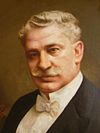
General elections were held in the Netherlands on 5 July 1922. They were the first elections held under universal suffrage, which became reality after the acceptance of a proposal by Henri Marchant in 1919 that gave women full voting rights. Almost all major parties had a woman elected. The number of female representatives increased from one to seven. Only the Anti-Revolutionary Party principally excluded women from the House of Representatives. Another amendment to the electoral law increased the electoral threshold from 0.5% to 0.75%, after six parties had won seats with less than 0.75% of the vote in the previous elections.
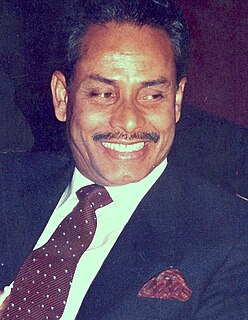
General elections were held in Bangladesh on 3 March 1988. They were boycotted by several major parties, including the Bangladesh Awami League, the Bangladesh Nationalist Party, the Communist Party of Bangladesh, Jamaat-e-Islami Bangladesh, the Bangladesh Krishak Sramik Awami League, the National Awami Party (Muzaffar) and the Workers Party of Bangladesh. The result was a victory for the Jatiya Party, which won 251 of the 300 seats. Voter turnout was 52.5%.

General elections were held in Mexico on 7 July 1952. The presidential elections were won by Adolfo Ruiz Cortines, who received 74.3% of the vote. In the Chamber of Deputies election, the Institutional Revolutionary Party won 151 of the 161 seats. These were the last presidential elections in Mexico in which women were not allowed to vote.
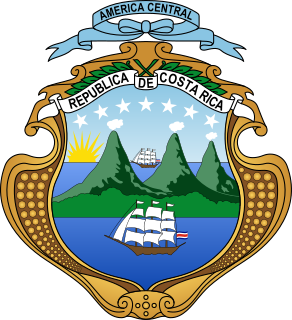
General elections were held in Costa Rica on 7 December 1913, the first direct elections since 1844. They were also the first elections to have universal male suffrage, after economic and educational requirements were eliminated. Máximo Fernández Alvarado of the Republican Party won the presidential election, but both he and runner-up Carlos Durán Cartín later resigned and Alfredo González Flores was appointed president by Congress on 8 May 1914. The Republican Party also won the parliamentary election. Voter turnout was 78.0% in the presidential election and 78.6% in the parliamentary election.

General elections were held in Costa Rica on 1 April 1917. Federico Tinoco Granados had seized power in a military coup in January and was the only candidate in the presidential election. The elections were considered to be fraudulent and although former president Rafael Yglesias Castro received 249 votes in Alajuela, they were recorded as invalid ballots. Voter turnout was reported to be 69.2% in the presidential election and 67.6% in the parliamentary election.

General elections were held in Costa Rica on 2 December 1923. Ricardo Jiménez Oreamuno of the Republican Party won the presidential election, whilst the party also won the parliamentary election, in which they received 51.5% of the vote. Voter turnout was 70.5% in the presidential election and 83.9% in the parliamentary election.

General elections were held in Costa Rica on 12 February 1928. Cleto González Víquez of the National Union won the presidential election, whilst the party also won the parliamentary election, in which they received 53.3% of the vote. Voter turnout was 62.5% in the presidential election and 72.85% in the parliamentary election.

General elections were held in Costa Rica on 14 February 1932. Ricardo Jiménez Oreamuno of the Independent National Republican Party won the presidential election, whilst the party also won the parliamentary election, in which they received 46.7% of the vote. Voter turnout was 64.2%.

General elections were held in Costa Rica on 9 February 1936. León Cortés Castro of the Independent National Republican Party won the presidential election, whilst the party also won the parliamentary election, in which they received 59.4% of the vote. Voter turnout was 68.8% in the presidential election and 68.9% in the parliamentary election.

General elections were held in Costa Rica on 1 February 1970. José Figueres Ferrer of the National Liberation Party won the presidential election, whilst his party also won the parliamentary election. Voter turnout was 83.3%.

Parliamentary elections were held in Portugal on 11 May 1919. The three main parties that boycotted the 1918 elections returned to contest the elections. The result was a victory for the Democratic Party, which won 86 of the 163 seats in the House of Representatives and 36 of the 71 seats in the Senate.

General elections were held in Peru on 14 April 1985 to elect the President and both houses of the Congress. Alan García of the American Popular Revolutionary Alliance won the presidential election with 53.1% of the vote, whilst his party emerged as the largest faction in both houses of Congress.
Elena Gallegos Rosales was the Salvadoran-born wife of the 24th President of Costa Rica. During her tenure as first lady, she was responsible for furnishing and establishing the new Presidential House, performing charitable works, and accompanying her husband on various diplomatic trips.
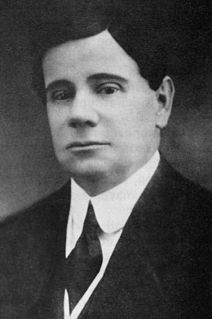
The 1917 Costa Rican coup d'état of 27 January 1917 was a rupture of the constitutional order in the Republic of Costa Rica, where the constitutional President Alfredo González Flores, was overthrown by his Minister of War and Navy Federico "Pelico" Tinoco and his brother and army commander José Joaquín Tinoco. The coup had the support of the Costa Rican oligarchy —mainly the bankers and coffee growers— affected by González's tax reform, particularly a greater tax burden for the big capital. Gonzalez did not enjoyed popular support as he had been appointed by Congress and not elected in open elections.

José Maria Soto Alfaro (1860-1931) was a surgeon and Costa Rican politician, brother of President Bernardo Soto Alfaro. Soto studied medicine at the University of Paris in 1885, practiced the first gastrostomy, thyroidectomy and cesarean section in Costa Rica. He practiced medicine at the Faculty of Medicine of Costa Rica and at the San Juan de Dios Hospital. sometimes deputy in the Constitutional Congress. Convinced tinoquista, he strongly supported the brief regime of two years imposed by the brothers Tinoco after the coup d'etat of 1917 and founded the "January 27 Club" in commemoration of the date of overthrow of Alfredo González Flores. After Federico Tinoco was overthrown and his brother José Joaquín was assassinated, Soto accepted to run as a presidential candidate against the opposition leader Don Julio Acosta García, although the nomination was merely symbolic since Acosta had the triumph assured it was important to avoid a single candidate election, something that it is recognized as a patriotic service.
The Peliquista Party was a Costa Rican political group, active between 1917 and 1919 during the Tinoco Brothers dictatorship following the 1917 Costa Rican coup d'état. The Peliquista Party emerged to participate in the elections of April 1917 to elect the President of the Republic and deputies for a Constituent Assembly. Its name derives from the nickname of "Pelico" with which the Provisional Head of the Republic was known, Federico Tinoco Granados, who was the party's presidential candidate and that election's sole candidate.

Liberalism in Costa Rica is a political philosophy with a long and complex history. Liberals were the hegemonic political group for most of Costa Rica’s history specially during the periods of the Free State and the First Republic, however, as the liberal model exhausted itself and new more left-wing reformist movements clashed during the Costa Rican Civil War liberalism was relegated to a secondary role after the Second Costa Rican Republic with the development of Costa Rica’s Welfare State and its two-party system controlled by social-democratic and Christian democratic parties.
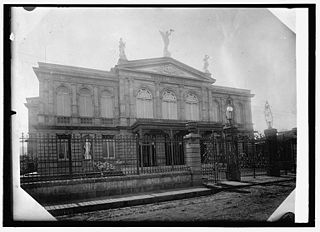
It is known as the Liberal State the historical period in Costa Rica that occurred approximately between 1870 and 1940. It responded to the hegemonic dominion in the political, ideological and economic aspects of liberal philosophy. It is considered a period of transcendental importance in Costa Rican history, as it's when the consolidation of the National State and its institutions finally takes place.

The history of the Costa Rican legislature is long and starts from even before its formal independence from the Spanish Empire. Costa Rica is one of the world's oldest democracies, thus, its parliamentary history dates back several centuries.



